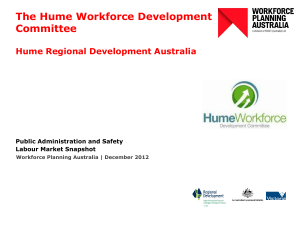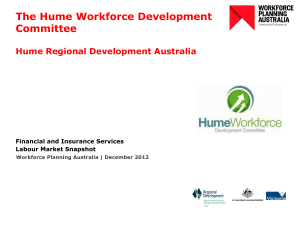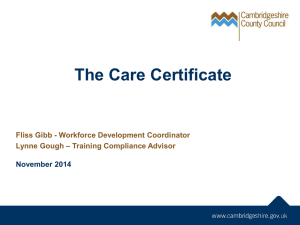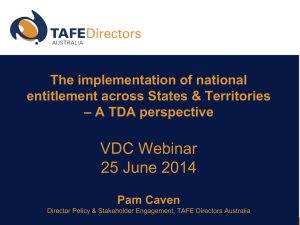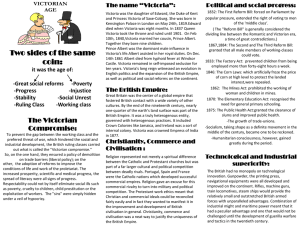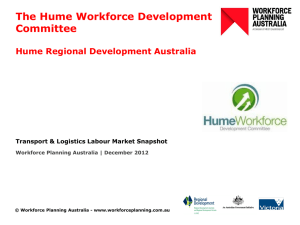DEECD Victoria
advertisement
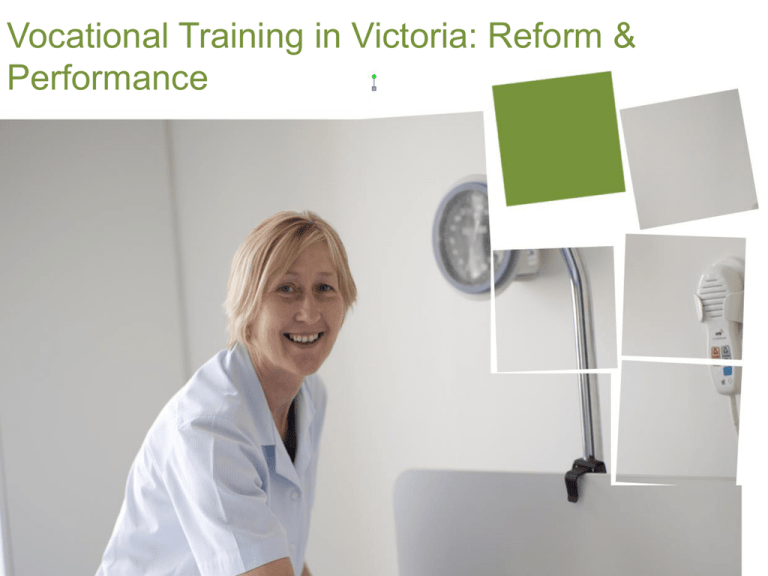
Vocational Training in Victoria: Reform & Performance A higher skilled workforce will be critical to securing Victoria’s future competitiveness Only half of working age Victorians have the core literacy and numeracy skills they need for work at a time of increasing structural change in our economy... We need higher level skills to arrest Victoria’s declining productivity… 2001 to 2005: Victoria’s multifactor productivity growth rate was half the national average 2006 to 2010: Victoria’s growth rate declined at five times the average annual rate of NSW We need to increase workforce participation to mitigate the costs of an ageing population and key workforce shortages (e.g. community services)… But 625,000 low skilled Victorians are in low skilled work or disengaged from work… Victoria’s VT system has been on a reform trajectory from a centrally planned model to a demand-driven model Problems with centrally-planned models: • Inefficient system with misaligned activity, both unmet demand and churn • Objectives not being met early 1990s Profile funding No market TAFE budget funded through contract TAFE attractsstudents Profile of activity funded mid 1990s- 2000s Purchaser provider Portion of funding contestable Government purchased places, mostly with TAFE Planned course provision with capped places Subsidy based on historical cost Fees regulated/capped Regulated fees Goal: Funding TAFE Goal: Drive efficiency 2008 - 2012 Student entitlement Open contestable market Student entitlement and choice of provider Uncapped places Subsidy based on course cost Fees regulated/capped 2012 Refocusing VET Fully contestable market Student entitlement and choice ofprovider Uncappedplaces Subsidy reflectssupplydemand and public value Flexible fees Goal: Modern Goal: Meet student system based on demand choice and competition The introduction of the Victorian Training Guarantee in 2009 placed purchasing power in the hands of students Victorian Training Guarantee: • Victorians aged under 20 can access training at any level, regardless of prior qualifications • Victorians aged 20 or over can access training in qualifications higher than those they already hold • Access to apprenticeship qualifications is unlimited to Victorians, regardless of age or prior qualifications The role of industry and employers in the training system has evolved, from passively lobbying government for places to actively engaging with individuals and providers Old model: Passive industry New model: Active industry Students Personal entitlement to subsidised training at provider of choice Government allocates fixed number of training places in specific courses Training Providers Industry & Employers offer fixed number of subsidised places Influence student choice and provider offerings Students access places on a first-come first-served basis Training providers Compete to attract students & employers Industry & Employers lobby for training places to meet skills needs Government Recent growth in national context… % change in number of students in AQF courses of study 2008 to 2012 (NCVER prelim June 2013) 70% 61% 61% 60% 50% 40% 30% 28% 24% 17% 20% 9% 10% 10% 0% -3% -10% ACT NSW NT Qld SA Tas Vic WA ‘Refocusing Vocational Training’ builds on the gains of the demanddriven system, while improving core elements of market design Entitlement Fundamentals retained Diversity of providers Differentiated subsidies Unbalanced public investment Supply-driven system • Victorian Training Guarantee retained • Funding directed to providers who meet quality requirements and attract students • Lower subsidies for higher quals that deliver greater private returns, but income –contingent loans so no upfront-fees • Subsidies targeted towards real job pathways • Deregulation of fees • Concessions and loadings for effective participation • Redesign of industry engagement • Improved information to the market Gaps addressed Gaps in quality assurance & market oversight Government policy constraining market-driven industry restructuring • Better commissioning • Improved monitoring of provider and market performance • TAFE transition • ACFE 10 year strategy Training activity to Q1 2013 46% 45% TAFE PRIV ACE 45% Enrolments patterns to Q1 2013 47% 9% 8% Q1 2012 Q1 2013 Patterns of Delivery to Q1 2013 Apprenticeship and Traineeship trends to Q1 2013 Activity is moving towards courses of higher public value and labour market need Direct Consultation The Minister for Higher Education and Skills talking directly to industry and employers Industry Skills Consultative Committee meets 3-4 times a year Monthly Industry Forums hosted by the Minister Seven to date Industry Associations Employers DEECD Market Facilitation and Information Skills Portfolio Skills Portfolio Skills Portfolio Wendy Timms John Spasevski Lee-Anne Fisher Building & Construction Agriculture, Forestry, Fishing Food & Beverage Wood, Pulp, Paper Hospital, Medical, Health Care Residential Care & Social Services ICT, Financial Service Furniture, Admin & support Education Machinery, Equipment, Transport, Manufacturing, Auto Road &Rail Transport Water, Air & other Transport Warehousing, Logistics & Storage Services Accommodation & Food Services, Personal Services Retail & Wholesale Trade Metals & Metal products Petroleum, Coal, Chemical, Polymer & Rubber products Non metallic & Mineral Products Electricity, Gas, Water & Water Services, Mining, Professional & Scientific Services TLFC, Property Services, Printing HESG Regional Facilitation Managers The objectives of vocational training • delivers a productive and highly skilled workforce • enables all working age Australians to develop the skills and qualifications needed to participate effectively in the labour market • contributes to Australia’s economic future • supports increased rates of workforce participation National Agreement for Skills and Workforce Development In shortage and specialised occupations Specialised or In Shortage enrolments as share of all industry -specific enrolments 40% 33% Q1 2012 Q1 2013 Enrolments in Victoria’s largest employing industries Employment and Enrolments 2012 (% total) Employment Enrolments Health Care and Social Assistance 12% 19% 11% Retail Trade 9% 11% 10% Manufacturing 9% Construction Professional, Scientific and Technical Services 13% 8% 3% Source: Monash CoPS • 54% enrolments in Victoria’s five largest employing industries (51% employment) • Enrolment shares exceed employment shares in health and construction - areas of relatively high shortages • Gap in Professional Services largely reflects the need for degrees or above Health care and social assistance Enrolments patterns to Q1 2013 Enrolments by Provider Type, Q1 2013 Top 5 Qualifications Q1 2013 Certificate III in Children's Services 8,576 Diploma of Children's Services (Early childhood education and care) 5,894 Diploma of Nursing (Enrolled-division 2 Nursing) 4,865 Enrolments in specialised & in-shortage related courses to Q1 2013 Certificate III in Aged Care 4,486 Certificate IV in Disability 2,273 Top 5 Qualifications in Q1 2013 Construction Enrolments patterns to Q1 2013 Enrolments by Provider Type, Q1 2013 Top 5 Qualifications Certificate III in Electrotechnology Electrician Enrolments in specialised & in-shortage related courses to Q1 2013 Q1 2013 4,902 Certificate III in Carpentry 4,097 Certificate III in Plumbing Certificate III in Civil Construction Plant Operations Certificate IV in Building and Construction (Building) 3,565 Top 5 Qualifications in Q1 2013 1,793 1,470 Manufacturing Enrolments patterns to Q1 2013 Enrolments by Provider Type, Q1 2013 Top 5 Qualifications Certificate III in Process Manufacturing Q1 2013 3,502 Certificate IV in Competitive Manufacturing 3,079 Certificate III in Engineering - Fabrication Trade 1,543 Certificate III in Competitive Manufacturing 1,478 Certificate III in Food Processing Enrolments in specialised & in-shortage related courses to Q1 2013 Top 5 Qualifications in Q1 2013 933 Victorian Training Market Quarterly Report Q1 2013 available at: www.education.vic.gov.au/training/providers/market/Pages/reports.aspx

